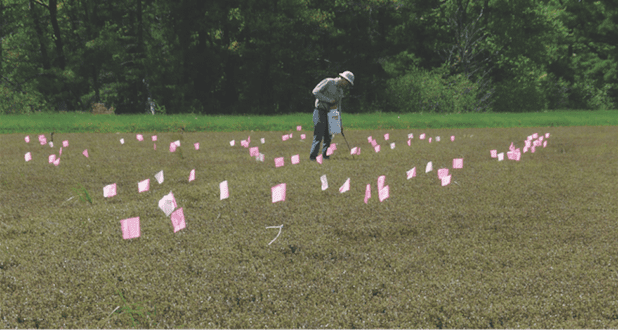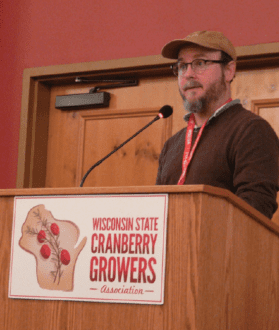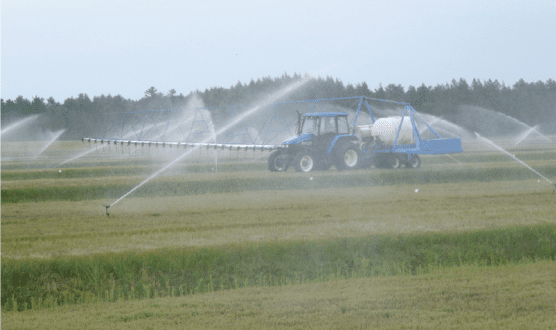

Mar 17, 2020Improved cranberry hybrids sought for Wisconsin growers
Lorraine Rodriguez-Bonilla spent two summers hiking through remote areas of northern Wisconsin and Minnesota searching for wild cranberries as part of an effort to develop cranberry hybrids better suited to growing in Wisconsin.
Rodriguez-Bonilla shared the results of her research at the 2020 Wisconsin Cranberry School held in January in Wisconsin Dells. The two-day event drew nearly 300 cranberry growers from Wisconsin, Michigan, Massachusetts, Nova Scotia, Ontario and Quebec.
A Ph.D. candidate in the plant breeding and plant genetics program at the University of Wisconsin-Madison, Rodriguez-Bonilla and her advisor Juan Zalapa, UW-Madison associate professor of horticulture and USDA-ARS research geneticist, are leading the first in-depth study of the genetic diversity of wild cranberry populations in the Upper Midwest.
Commercial cranberry production in the U.S. began in the early 1800s. Early cranberry growers first cultivated native wild cranberries, and later began selecting vines that exhibited more desirable traits, such as larger fruit or earlier maturity.
The majority of today’s cranberry hybrids have been derived from seven wild selections, the oldest dating back to 1835: Early Black, Howes, McFarlin, Searles, Potter’s Favorite, Ben Lear and LeMunyon. Of the seven, only three – Searles, Potter’s Favorite and Ben Lear – are Wisconsin natives. The rest are Massachusetts and New Jersey varieties.
“Most of the cultivars that we grow come from the same selections, so they are very close genetically and that means that eventually – as has happened in other crops – they can be susceptible to disease and changes in temperatures and other stressors,” Rodriguez-Bonilla said.
Seeking to increase the genetic diversity available to plant breeders, Rodriguez-Bonilla and her team collected wild cranberries from populations growing in state natural areas, national forests and other isolated areas of northern Wisconsin and Minnesota. In all, the team collected 572 plants from 36 sites.
The team found both Vaccinium macrocarpon or American Cranberry, which is the species cultivated by cranberry growers, and Vaccinium oxycoccos, a wild ancestor of the American Cranberry commonly known as Small Cranberry or Bog Cranberry.
Because V. oxycoccos is adapted to high latitudes and harsh winters, it might provide a source of cold hardiness genes and other desirable traits for developing new hybrids better adapted to Wisconsin’s cranberry growing conditions, Rodriguez-Bonilla said.
Speaking of the wild populations of cranberries that still exist, Rodriguez-Bonilla said, “It’s very amazing that we have this resource right here in Wisconsin and that we can protect it and care for it.”
Nematodes as bioinsecticide
Other University of Wisconsin-Madison researchers have also been searching areas in Wisconsin where wild cranberries grow looking for natural enemies of the insect pests that attack commercially grown cranberries.


University of Wisconsin-Madison entomologist Shawn Steffan updated growers on his research using native nematodes to kill cranberry insect pests that he and former graduate student Shane Foye began five years ago.
Steffan, who holds a dual appointment as a research entomologist with the USDA-Agricultural Research Service, and Foye, who recently earned his doctorate in entomology at UW-Madison, hypothesized that nematodes with the ability to control cranberry insect pests must exist in the wild marshlands of Wisconsin.
“In every ecosystem, you have native plants, you have native herbivores and you also have native carnivores. So, we thought surely there are very specific natural enemies of the insect pests of cranberries, because that’s just how nature works,” Steffan said.
Foye had already studied nematode ecology while working on his master’s degree at Oklahoma State University, so when he joined the Steffan Lab in 2015, he and Steffan began looking for native nematodes among populations of wild cranberries growing in central Wisconsin.
In their search, Foye and Steffan found two species of nematodes native to Wisconsin – Oscheius onirici and Heterorhabditis georgiana – that showed promise in controlling certain cranberry insect pests, including redheaded flea beetle.
As with all entomopathogenic nematodes – which are small, translucent roundworms – O. onirici and H. georgiana invade insect hosts in order to complete its life cycle, killing the host in the process.
In field studies, Foye treated 2-foot by 6-foot caged plots with the two species of nematodes. While the control plots had an average of four flea beetles, the nematode-treated plots had an average of 1.1 flea beetles.


Steffan and Foye then began looking at methods cranberry growers could use for applying the nematodes on their cranberry beds. They tried cranberry boom sprayers but found the fine droplet size of the spray nozzles impacted the survival of the nematodes.
“Basically, the nematodes come out the other end of the nozzles and they’re just dazed and confused,” Steffan said.
But simply removing the spray nozzles and using a coarse spray to apply the nematodes solved that problem. After the nematodes were applied with the sprayer equipment, the cranberry beds were irrigated for one to two hours to move the nematodes down through the plant canopy to the soil surface.
During their farm-scale efficacy trials in 2018, Steffan and Foye found the nematode-treated beds had an average of 45% fewer flea beetles than the control beds.
“We feel this bioinsecticide is a potential replacement for one – possibly two – insecticide sprays, depending on the efficacies of those sprays,” Steffan said.
Steffan is now working on developing a system that would allow cranberry growers to mass produce their own nematodes.
Tracking insect development
Steffan also updated growers on another study in which he is testing the use of degree days to better time applications of insecticides to control sparganothis fruitworm.
Since insects are cold blooded, Steffan and his graduate students have been tracking the development of sparganothis fruitworm using phenological degree days to predict their development.
Degree day models are based on the lower and upper temperature thresholds for larval development, which varies by insect species. In the case of sparganothis development, the thresholds are 50˚ F and 86˚ F. Sparganothis eggs begin to hatch when 895 degree-days have accumulated.
Trials were done in 2018 looking at insecticide applications made at different times based on degree days. Plots received one of three treatments: insecticide applied at 1,140 degree days when 25% of sparganothis eggs had hatched, at 1,640 degree-days when 75% of the eggs had hatched, and third treatment had applications at both the 25% and 75% egg hatch.
Not surprisingly, the earlier insecticide spray produced the best pest control. The plots receiving the later application had significant levels of infested fruit. Fruit quality in the plots that received the two insecticide applications was not significantly different than plots receiving the single early application.
“That’s because the application at 25% egg hatch was so good, there was just no room for improvement. So, adding that extra spray was unnecessary,” Steffan said.
In 2019, Steffan and his students did additional trials when the sparganothis egg hatch was at 10% 25% and 40% using a 4.5-ounce rate of Altacor insecticide. Results showed that spraying at 40% egg hatch was too late, while control with the two earlier applications was essentially the same.
Steffan is recommending timing insecticide applications between the 10% and 25% egg hatch period for optimal control of sparganothis.
“You can accrue weather data for your own marsh and keep track of when you hit certain benchmarks. At 895 degree-days is when the first eggs hatch. The window between 1,000 and 1,140 degree-days is likely the best time to spray for sparg,” Steffan said.
— Lorry Erickson, FGN correspondent














